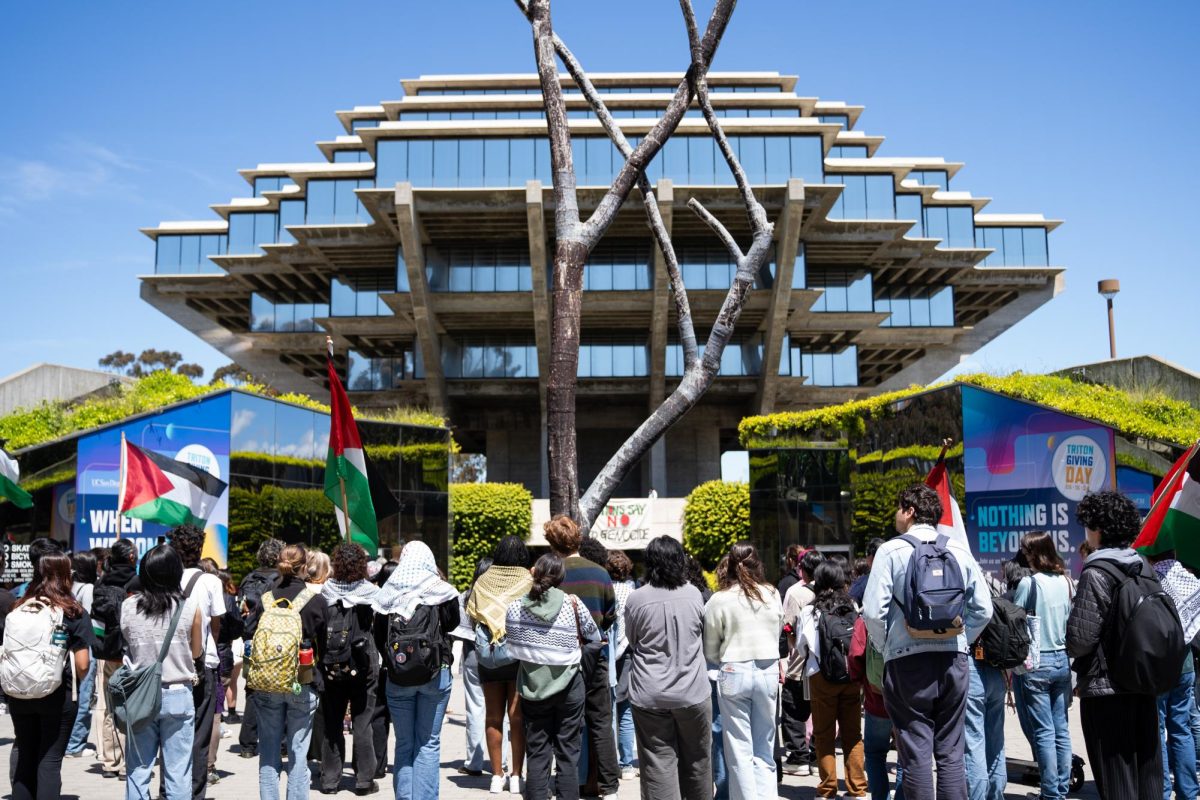In RIMAC Arena, the trophies of many past UCSD conquests sit. Banners touting the national championships of past Triton teams ring the ceiling of the arena and serve as a reminder of UCSD’s dominance over other teams. Recently raised to join the company of the multitude of Division III banners is one that catches the attention of any fan who enters the arena: a banner for the 2000 men’s water polo team, sporting the unfamiliar marking of Division I. This weekend, the Tritons again have a chance to add a Division I banner to the rafters if the water polo team can get past Stanford in the first round of the National Collegiate Athletic Association Water Polo National Championships.
For now, the men’s water polo division is the exception rather than the rule. Most Triton teams currently compete at the Division II level, but how long will that last? UCSD is already larger than most Division I schools, and by 2015, UCSD is projected to have 29,300 students — nearly three times the size of the average Division I school. It appears a move to the “”big time”” is inevitable, but there are a number of hurdles that the program has to clear before it can consider such a move.
A.S. Commissioner of Athletics Robin Shelton feels that UCSD is not quite ready for Division I yet.
“”At this current time, we are not ready to move to Division I, and would not be prepared to go,”” said Shelton, a former member of the Triton golf team. “”Currently, there are things that must improve before such a move takes place.””
Shelton cited the lack of equipment, office space and weight room facilities as examples of problems that need to be rectified before the program could consider a move up to Division I.
However, Shelton felt that the most important factor in any move, UCSD athletes, would be prepared for Division I.
“”Our athletes would be ready for the move,”” he said. “”We have some amazing athletes with incredible amounts of talent. Many people asked the same question when we moved from Division III to Division II. In our first year in Division II, we finished fourth in the Sears Director Cup without any scholarships.””
Scholarships will play a large role in any future move. Currently, NCAA Division I bylaws state that a Division I institution must award “”financial aid representing a minimum aggregate expenditure of $771,000 (with at least $385,000 in women’s sports)”” annually.
Notably, Division II recently put in place a similar scholarship requirement; UCSD requested and has received an exemption. As a result, UCSD will continue for the foreseeable future to be the only Division II non-scholarship school in the country.
Given the stricter requirements of Division I, UCSD would probably have a tougher time getting an exemption from scholarship requirements at that level.
During the move to Division II, the California Collegiate Athletic Association invited UCSD to join its membership. The department would likely look for a similar invitation from a conference when moving to Division I. UC Davis was heavily recruited by the Big West Conference as member No. 9, and it is rumored that the Big West is looking for another California school to make its membership even. Could UCSD be Big West member No. 10?
“”I think we’re a long way from anything like that,”” said Associate Athletic Director Ken Grosse when asked if UCSD could follow the path of UC Davis. “”First, we want to be a consistent competitor in the CCAA and in Division II.””
Meanwhile, since the founding of the campus, UCSD faculty and administrators have been consistent in their stance toward the athletics program. In 1969, Revelle College Provost Paul Saltman stated that the fledgling sports program “”is and should remain an extracurricular function. At no time should it interfere with the academic or scholastic standards of UCSD.”” Saltman was concerned that if UCSD began granting athletic scholarships, the program would turn into a UCLA- or USC-type football machine, which would consequently lower academic standards.
A similar stance was taken by the Academic Senate in April 1998 during discussion of the move to Division II. The final motion approved by the Academic Senate asked that the chancellor “”initiate the process for a smooth transition to Division II intercollegiate athletics with no athletic scholarships, no scholastic variations in admissions and no use of general funds.””
In terms of athletic scholarships, students have recently agreed with the Academic Senate. The 1997 Division II referendum explicitly stated that scholarships would not be granted if the program were to move to Division II. The measure, which did not ask for a fee increase, passed by an overwhelming majority.
Just last spring, a fee increase was approved to put the athletics department on solid financial footing for Division II.
With the need for improved facilities, more coaches and administrators, longer travel distances and possibly scholarships, any future move to Division I will require an additional substantial increase in the athletics program budget.
One option available through a Division I sports program is increased attention from the media. With that focus would come more fans and better opportunities to generate money through advertising and sponsorships, but not in San Diego.
“”San Diego is a town that already has a number of pro teams, two other D-I schools and it’s a soft market for entertainment,”” Grosse said. “”There’s just too much to do here.””
Television market ratings support Grosse’s assessment. Though San Diego is the seventh-largest city in the United States, it has only the 26th-largest television market. Ranking ahead of San Diego are much smaller markets, including UC Davis’ metropolitan Sacramento market at No. 19.
Unless a wealthy UCSD alumnus offers to step in with a generous donation to the athletics department, it appears that students will have to foot the bill for any move up through an increase in student fees. With the current overcrowding on campus, which is only projected to get worse, many students feel that any increase in fees should first go toward other proposed projects, such as expansions of the Price Center and the Student Center.
“”Last year’s referendum signaled an upward swing of athletic support on campus,”” said Jordan Cross, who served on the athletics referendum committee. Cross noted the differences between UCSD and UC Davis, which recently passed a major referendum to support its planned move. “”I do not believe that UCSD students would be supportive of the much more expensive move to D-I,”” he said.
Though UC Davis and UCSD appear to be similar at first glance, there are clear differences when it comes to location and financial priorities. UC Davis recently passed a fee similar in structure to UCSD’s failed Campus Life Referendum fee. Students voted to increase fees by more than $100 per quarter, with a majority of the fee going to support the move to Division I.
UC Davis also currently offers athletic scholarships at the Division II level, and intends to increase the number of scholarships offered in Division I.
UCSD, on the other hand, is not located in a small farming community, and has many other outlets for entertainment besides sports.
Tom Ham, a local restauranteur and supporter of the short-lived UCSD football program in the 1960s, once said that UCSD would have no future in San Diego if it did not move toward a “”big-time”” athletics program immediately.
UCSD scrapped its football program after the winless 1968 season.
Since then, UCSD has changed and grown by leaps and bounds. In 1970, UCSD boasted slightly over 4,000 students. The latest figures from the registrar’s office indicate 23,548 students enrolled in UCSD this fall. Academically, UCSD has — in just 42 years — developed an international reputation that much older institutions with well-known sports programs can only dream of.
Whether or not the lack of a big-time sports program had a hand in the university’s academic climb to the top is debatable. Some feel that UCSD would have gone the way of USC had it followed Ham’s proclamation. Others feel it would have done no harm to UCSD’s academic prowess.
Regardless of the past, many feel that it makes sense for the athletics program to keep pace with the rest of the university.
Shelton believes the athletics program is keeping up with growth.
“”Everything about our program is heading in [the Division I] direction in terms of the success and class of the operation,”” he said.
If there’s one thing that UCSD has always excelled at, it’s innovation. From the founding of Revelle College in 1960 to the recent creation of the new management school, the campus as a whole has always strived to develop and change in a successful yet unique fashion.
The athletics department has followed a similar pattern, refusing to bow to the trend of emphasizing big sports like basketball while cutting others to maintain a balanced budget.
“”They do a fantastic job with what they have,”” Shelton said, who works closely with administrators at the athletics department as part of his position on A.S. Council. “”The athletic director [Earl Edwards] and his entire administration and coaches do an amazing job which I think is evident in their success.””
For now, even though some statistics indicate otherwise, Division II looks like the best fit for the Triton athletics program. It’s what a majority of students want. But with the constant rehashing of NCAA regulations and the changing student body, the situation will be vastly different in the future.
Already, the newest UCSD students are examining athletics and coming to different conclusions. Eleanor Roosevelt College Freshman Senator Max Harrington thinks current students “”would financially support a move to Division I because of the enhanced status and prestige that it would carry.”” He also believes students would support athletic scholarships, but he also noted other pressing issues on campus such as funding for club sports and student organizations.
When the campus decides the time is right to move up, count on the Tritons doing it in a successful and innovative way. In the meantime, the Tritons will continue to strive for Division II excellence and consistency while they try to add a few more banners to the RIMAC rafters.







